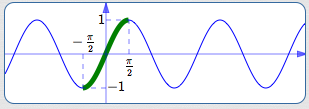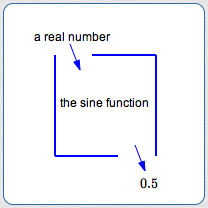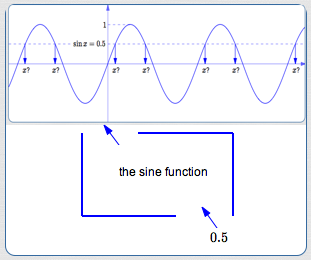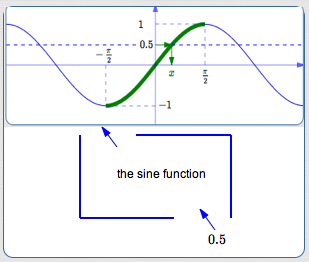 Inverse Trigonometric Function: Arcsine (Part 1)
Inverse Trigonometric Function: Arcsine (Part 1)
(This page is Part 1. Click here for Part 2.)
Before studying this section, you are encouraged to read Trying to ‘Undo’ Trigonometric Functions.
For a function to have an inverse, each output must have exactly one corresponding input. Thus, only one-to-one functions have inverses.
The sine function doesn't have a true inverse, because the sine function is not one-to-one. So, to try and define an ‘inverse sine function’, we do the best we can, as discussed below.
To try and define an ‘inverse sine function’, proceed as follows:
Throw away most of the sine curve, leaving us with a piece that has three properties:
- the piece is one-to-one (and hence has an inverse)
- the piece covers all the outputs from the sine function (the interval $\,[-1,1]\,$)
- the piece is close to the origin

The green piece shown above satisfies all three of these properties. This green piece is the restriction of the sine curve to the interval $\,[-\frac{\pi}{2},\frac{\pi}{2}]\,.$
The function that the mathematical community calls ‘the inverse sine function’ is not actually the inverse of the sine function, because the sine function doesn't have a true inverse. Instead, the ‘inverse sine function’ is the inverse of this green piece of the sine curve.
Several Cycles of the Graph of the Sine Function

The sine function isn't one-to-one; it doesn't pass a horizontal line test. So, it doesn't have a true inverse.
To define an ‘inverse sine function’, we do the best we can. Throw away most of the curve—leave only the green part.
This green part is one-to-one. This green part does have an inverse.
The inverse of this green part is what the mathematical community calls ‘the inverse sine function’.
The arcsine function (precise definition below) is the best we can do in trying to get an inverse of the sine function. The arcsine function is actually the inverse of the green piece shown above!
Here's a ‘function box’ view of what's going on:
The sine function takes a real number as an input. It gives an output in the interval $\,[-1,1]\,.$
For example (as below), the output $\,0.5\,$ might come from the sine function.

When we try to use the sine function box ‘backwards’, we run into trouble.
The output $\,0.5\,$ could have come from any of the inputs shown.

However, when we use the green piece of the sine curve, the problem is solved!
Now, there's only one input that works. (It's the value of the green $\,\color{green}{x}\,.$ )
Observe that $\,\color{green}{x}\,$ is in the interval $\,[-\frac{\pi}2,\frac{\pi}2]\,.$

It's a bit of a misnomer, but the arcsine function (precise definition below) is often referred to as the ‘inverse sine function’. A better name would be something like ‘the inverse of an appropriately-restricted sine function’. (It's no surprise, however, that people don't say something that long and cumbersome.)
So, what exactly is $\,\arcsin 0.5\,$?
What Exactly is $\,\arcsin x\,$?
More generally, let $\,x\,$ be any number in the interval $\,[-1,1]\,.$ Then:
In my own mind (author Dr. Carol Burns speaking here), the words I say are:
I personally know the endpoints are included, so this doesn't confuse me. However, the word ‘between’ is ambiguous—it can include the endpoints or not, depending on context. It can be clarified by saying:
... but then it loses its simplicity. Ah—issues with language. Choose words that work for you!
Precise Definition of the Arcsine Function
The precise definition of the arcsine function follows. It can look a bit intimidating—the notes following the definition should help.
Let $\,-1 \le x\le 1\,.$
Using the notation ‘$\,\arcsin\,$’ for the arcsine function:
$$ \begin{gather} \cssId{s62}{y = \arcsin x}\cr\cr \cssId{s63}{\text{if and only if}}\cr\cr \cssId{s64}{\bigl(\ \sin y = x\ \ \text{and}\ \ -\frac{\pi}{2} \le y\le \frac{\pi}{2}\ \bigr)} \end{gather} $$Using the notation ‘$\,\sin^{-1}\,$’ for the arcsine function:
$$ \begin{gather} \cssId{s66}{y = \sin^{-1} x}\cr\cr \cssId{s67}{\text{if and only if}}\cr\cr \cssId{s68}{\bigl(\ \sin y = x\ \ \text{and}\ \ -\frac{\pi}{2} \le y\le \frac{\pi}{2}\ \bigr)} \end{gather} $$Notes on the Definition of the Arcsine Function
Understanding the Definition
The definition precisely answers the question: ‘What is the number $\,\arcsin x\,$?’ Here's how:
Recall that ‘ if and only if ’ means the same thing as is equivalent to. Equivalent sentences have identical truth values: if one is true, so is the other; if one is false, so is the other.
Thus, if the sentence ‘$\,y = \arcsin x\,$’ is true, then the compound sentence
$$\cssId{s79}{\sin y = x\ \ \text{and}\ \ -\frac{\pi}{2} \le y\le \frac{\pi}{2}}$$must also be true.
If ‘$\,y = \arcsin x\,$’ is true, then ‘$\,y\,$’ is just another name for ‘$\,\arcsin x\,$’.
If ‘$\,y = \arcsin x\,$’ is true, then two things must be true about $\,\arcsin x\,$ (i.e., $\,y\,$):
- $\sin \overbrace{y}^{\arcsin x} = x\,$: its sine must be $\,x$
- $-\frac{\pi}{2} \le \overbrace{y}^{\arcsin x}\le \frac{\pi}{2}\,$: it must be in the interval $\,[-\frac{\pi}{2},\frac{\pi}{2}]$
Combining these ideas:
$$ \begin{gather} \cssId{s88}{\overbrace{\strut y = \arcsin x}^{\text{How does a number get to be called $\,\arcsin x\,$?}}}\cr\cr \cssId{s89}{\overbrace{\strut \text{if and only if}}^{\text{The answer is:}}}\cr\cr \bigl(\ \cssId{s90}{\overbrace{\strut \sin y = x}^{\text{by having its sine equal to $\,x\,$}}}\ \ \cssId{s91}{\overbrace{\strut \text{and}}^{\text{and}}}\ \ \cssId{s92}{\overbrace{\strut \ -\frac{\pi}{2} \le y\le \frac{\pi}{2}\ \ }^{\text{by being in the interval $\strut \,[-\frac{\pi}{2},\frac{\pi}{2}]\,$}}}\ \bigr) \end{gather} $$That is: